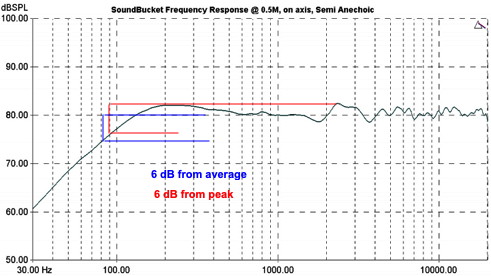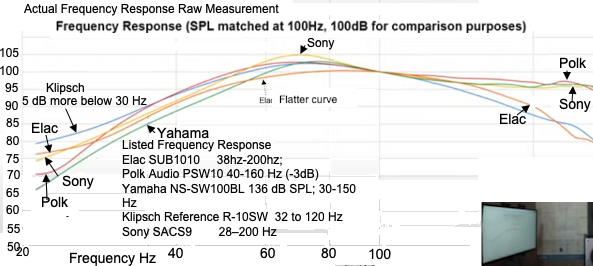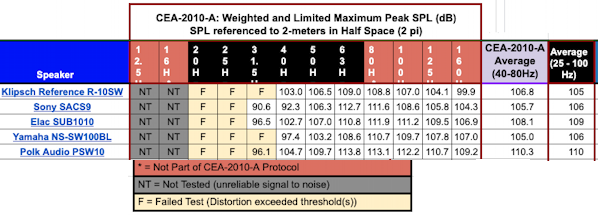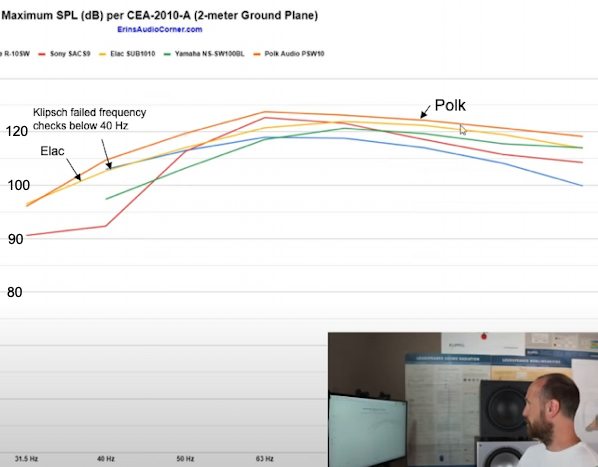last updated 2 Apr 2022

The industry standard is a response quoted with +/- 3dB tolerance levels.
Examples from above:
95 20,000Hz, +/-3dB, ref 1KHz
85 20,000Hz, +/- 3dB
Musical Instruments with low bass at Sound in tech.
Piano A0 (28 Hz) to C8 (4,186 Hz)
Bass C1 (33 Hz) to C5 (523 Hz)
Picolo C5 (523 Hz) to B7 (3,951 Hz)
Guitar (Bass) 4 string E1 (41 Hz) to C4 (262 Hz)
Barritone Sax C2 (65 Hz) to A4 (440 Hz)
Harp (28 Hz) to (32,000 Hz)
Tuba (45 Hz) to (380 Hz)
Large Pipe Organ with a 32 foot stop in the pedal (16 Hz)
Frequencies within the range of 4 to 16 Hz are felt but not heard.
Example from Budget <$200 10 inch subwoofers | Erin's Audio Corner
For subwoofers anyway the standard range seems to be +/- 5dB

Tests using Consumer Electronic Association CEA-2010-A and CEA-2010-B metrics of defining a subwoofer’s maximum SPL based on a set of harmonic distortion thresholds.



Frequency Response Specs - Soundbucket Speakers
Response without tolerances
So how can we display the figures without a chart? Taking the SoundBucket chart above heres some possibilities, all true.
The SoundBuckets frequency response is:
- 30-20,000Hz
- 110-20KHz, +/-2dB, ref 1KHz
- 95-20,000Hz, +/-3dB, ref 1KHz
- 85-20,000Hz, +/- 3dB
- 60-20,000Hz, +/- 5dB
- 30-20,000Hz, +/-10dB
[ I spent several hours trying to finda better explanation of the reference with no luck]
You can see how misleading these figures can be! What you also cant see is whats happening between the frequencies mentioned. There could be massive peaks and troughs all over the response youd hear these as unpleasant colouration. But as long as those peaks and troughs werent bigger than the tolerance, you wouldnt be lying!
Also its helpful to have a 0dB reference. The 4th set of figures above demonstrates this 85Hz is 6dB less than the 2dB peak at 2200Hz. If you listened to the speaker though with music, the level at 85Hz would be 4dB less than the average level.
Finally, most portable speakers use digital loudness compensation. What this means is that they boost the bass at low volumes to make it sound bassier. This is OK, except that when the volume goes up, they cant cope, so they reduce the amount of bass they produce. At a low listening level they may boast a LF response of 80Hz, but at volume, the response could change to a high 150Hz!
So how do you read response figures without charts?
- If there is no tolerance quoted, ignore it completely. Its a useless measurement that does not tell you anything about the speaker
- The industry standard is a response quoted with +/- 3dB tolerance levels. Ignore tolerances larger than this as they can hide nasty problems in the midrange.
- Ideally look for a reference point 1KHz is typical, or you could be describing a curve, not a line.
- Look for a reference level for the reference point 85dB at 1M is common. If not the speaker could have a loudness curve, and loose the bass at volume.
- The tighter the tolerance over the wider the frequency range the bette
r
Finally its often useful to quote a figure when the bass drops below 10dB of the rest of the response. This represents half the loudness, and its a good indicator of how low you can hear bass notes. Most portable speakers drop off really quickly ( 4th order filter), but the SoundBuckets drop off half as fast (2nd order filter). From the above, the SoundBucket figure is about 55Hz. This should be shown as: LF cutoff: -10dB @ 55Hz (ideally referenced to 1KHz).
Last Word
Not all charts are the same. Speakers can be measured differently, the responses can be filtered to make them loom smoother than they really are, and (my favourite) the vertical scale can be compressed. A 10dB vertical scale is the standard, but beware no scale or 20dB scales the responses can look amazing!
See Subwoofers. for some examples
Terms:
Loudness is measured in decibels (dB). A decibel is one tenth of a bel, a seldom-used unit named in honor of Alexander Graham Bell.
It is a logarithmic (base 10) scale so 20 dB has 100 times the power as 10 dB. 30 dB has 1,000 times.
A-weighted decibels, abbreviated dBA, or dBa, or dB(a), are an expression of the relative loudness of sounds in air as perceived by the human ear.
The human ear is more sensitive to Frequency Response Specs in the frequency range 1 kHz to 4 kHz than to Frequency Response Specs at very low or high frequencies. dBa adjusts Frequency Response Specs level down at low and high frequencies to compensate for this.
See: Decibel A, B and C at EngineeringToolbox.com
Sounds with a loudness of 120 dB
or more can cause pain and damage to the human ear.
Links:
Subwoofers
Frequency Response Specs - Soundbucket Speakers
Audio - stereo - Home Theater (Surround Frequency Response Specs) in home and garden.
+/-3 dB or -6 dB: What's the Difference? - ProSoundWeb
Understanding Speaker Frequency Response - ecoustics.com
 Technology
Technology
 Frequency Response Specs
Frequency Response Specs
 Technology
Technology
 Frequency Response Specs
Frequency Response Specs




